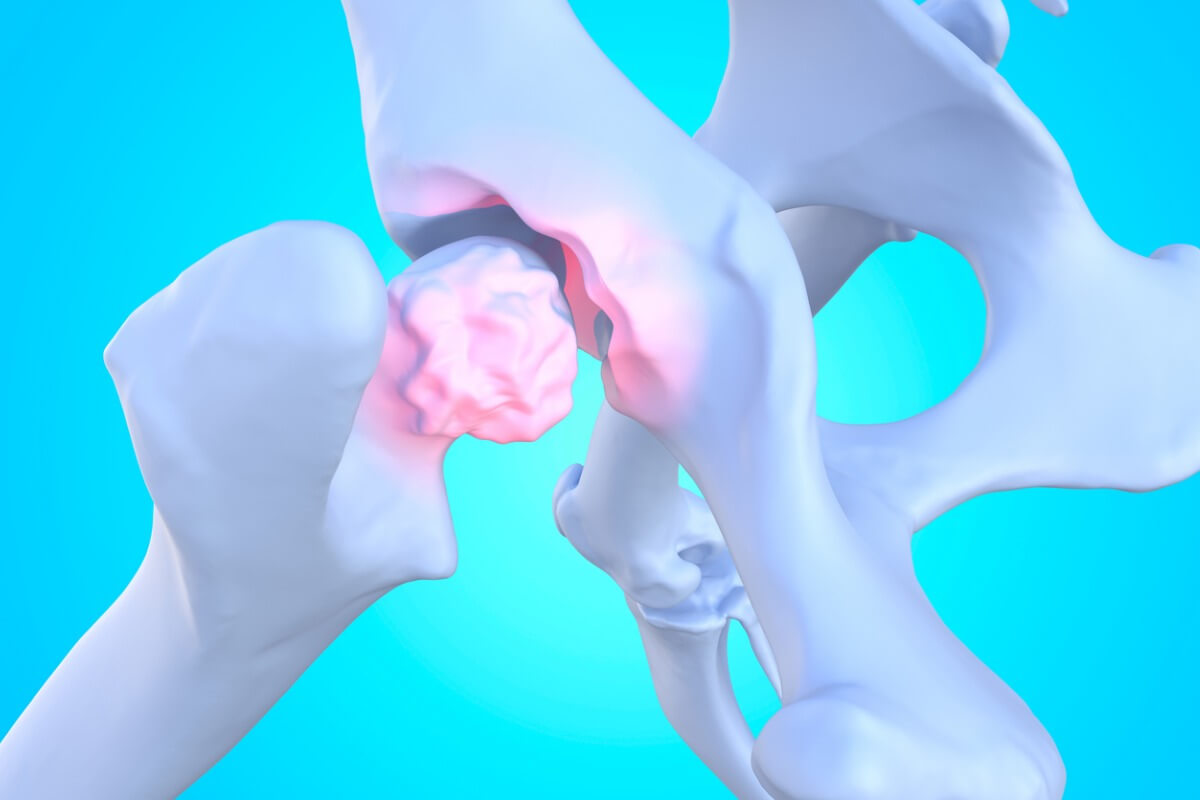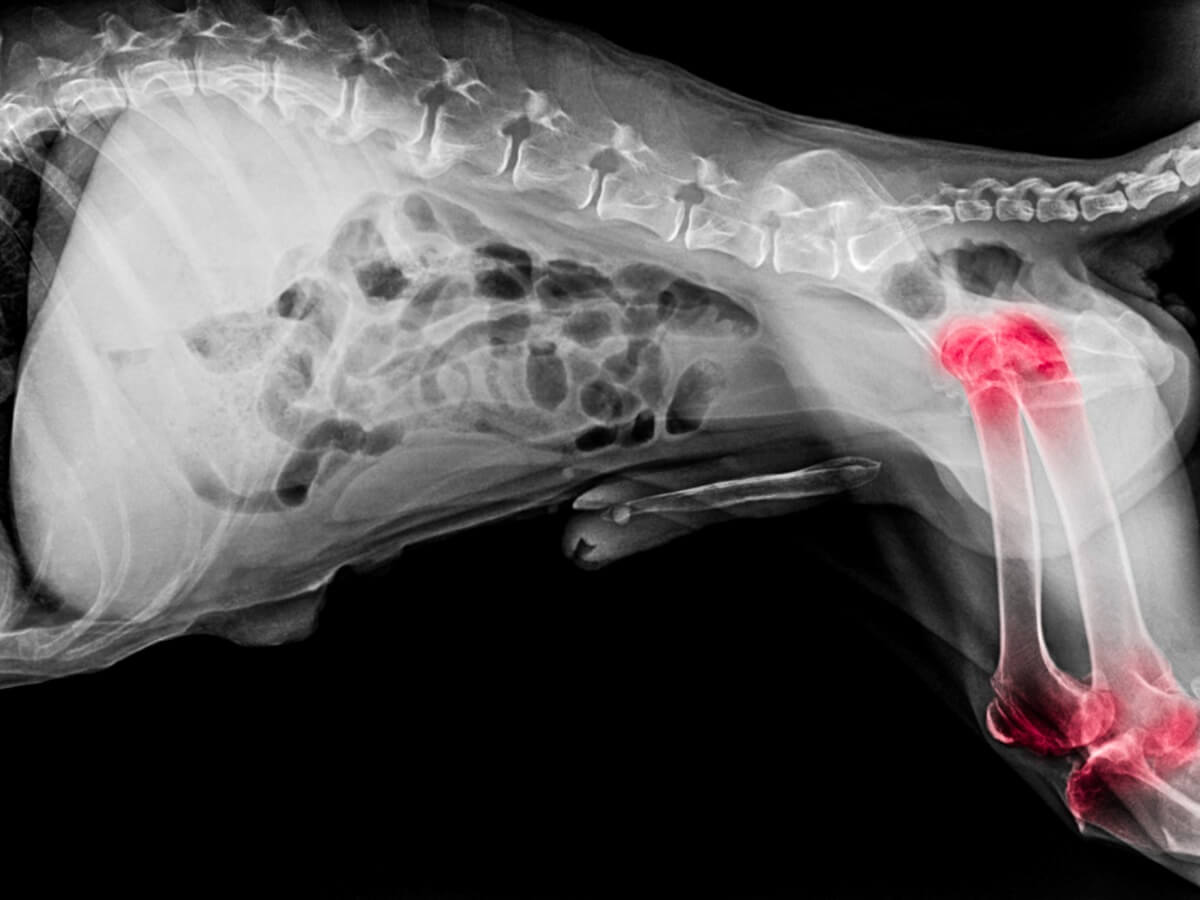Differences Between Arthritis and Osteoarthritis in Dogs


Written and verified by the biologist Cesar Paul Gonzalez Gonzalez
Arthritis and osteoarthritis are very common ailments in dogs, as the wear and tear of the joints often leads to one of these two diseases. Although the symptoms may appear similar, the causes and consequences of each one are different. Learning to differentiate between the two will help the owner to better understand what their pet is going through.
These types of diseases can restrict a dog’s movement, so it’s important to seek veterinary help when they’re detected. Also, the more you know about these conditions, the sooner you’ll be able to recognize the best ways to make your pet feel good. Read on to learn the differences between arthritis and osteoarthritis.
Why are joints so important?
A joint is the place where two or more bones join together and they’re necessary for your body to be able to move. In other words, joints are the points at which you can flex, contract, or extend your limbs. Although it may not seem like it, these joints are very important for everyday life, because without them it would be impossible to perform any type of movement.
Joints need different structures to perform their function, because each movement must be regulated or it could damage the body. Among the most important parts that make up a joint are the following:
- Capsule: This is a type of membrane that covers the joint, so it covers the before and after joints. Because of the way it’s distributed, the point where the two bones meet is “hollow”, which allows the membranes and cartilage to attach.
- Ligaments: In appearance, they’re similar to tendons, but with the great difference that they join bone to bone. In general, their function is to limit movement, so they serve almost like flexible rods that hold bones in place.
- Synovial membrane: This membrane is located right in the gap left by the capsule, as it’s responsible for allowing the passage of synovial fluid, which reduces the friction of the bones. Seen in another way, the synovial membrane forms a type of “bubble” that cushions the union of the bones.
- Cartilage: This is perhaps the most important part of the joint, as it prevents the bones from rubbing against each other. In other words, cartilage is a kind of “cushion” that exists between the bones that make up the joint. This structure allows movements to be fluid and prevents bone wear and tear.

What is the difference between arthritis and osteoarthritis in dogs?
As mentioned, arthritis and osteoarthritis can present a series of similar symptoms, but the origin of the diseases is quite different. This is because in each condition a different structure of the joint is affected. In arthritis, there’s inflammation of the synovial membrane, while in osteoarthritis there are problems with the cartilage.
How does arthritis appear?
Arthritis affects a large number of dogs, as the joints are the most frequently used parts of the body. In general, any damage and injury to the synovial membrane or capsule results in inflammation of the joint. This means that arthritis can be caused by various factors, including the following:
- Orthopedic diseases: As a consequence of dysplasia, osteochondrosis or degeneration of the ligaments.
- Infections: Due to bacteria, viruses, or fungi.
- Immune: As a response to an autoimmune disease.
- Characteristics of the dog: The weight of the pet and the amount of exercise it gets.
- Accidents: Blows or excessive movements that injure the joint.
Most of the causes are usually chronic-degenerative, so the pet will have to live with this disease for the rest of its life. In addition, if the condition isn’t diagnosed in time, the damage to the joints can be permanent, so it isn’t uncommon for the dogs to lose considerable mobility.
How does osteoarthritis appear?
On the other hand, osteoarthritis is a different condition from arthritis, as it’s characterized by the progressive loss of cartilage. As the disease progresses, the dog completely loses its mobility in the affected area, as the shock absorber between the two bones no longer exists. Osteoarthritis can be caused by a number of factors, including the following:
- Previous orthopedic disease: Dysplasia, osteochondritis, dislocation, or degeneration of ligaments.
- Genetics: In some cases, it occurs without apparent cause, so it’s considered to have factors related to the genetics of the pet.
- Age: The most affected dogs are those of advanced age.
Symptoms of arthritis and osteoarthritis in dogs
These diseases have similar symptoms, as they both affect the joints. The following list compiles the most obvious signs in dogs that can indicate the presence of arthritis or osteoarthritis.
- Unsteady gait (limping and lameness).
- Stiffness or limitation of joint movement.
- Inflammation of the joint (in osteoarthritis is not always evident).
- Pain to the touch
- A change in sitting posture.
- Decreased activity (reluctance to walk or move).
- Difficulty sitting up (problems getting up or standing).
- Lethargy.
In osteoarthritis, there isn’t as much pain if the joints don’t move, while in arthritis the pain continues even if they rest. In addition, as the disease worsens, all the symptoms begin to worsen, so if you notice a change in the behavior of your pet, then go immediately to the vet.
How are these diseases diagnosed?
The diagnosis of arthritis and osteoarthritis is complicated, as there’s no infallible way to detect them. The veterinarian has to make use of the dog’s medical history and physical tests, with which they’ll try to identify the severity and type of disease. In addition, in cases where an infection is suspected, samples will be taken for analysis.
Treatments available
Although the mechanism of these diseases is well understood, there’s still no drug that can cure them. In fact, the available treatments are considered palliative, as they’re only limited to reducing discomfort and preventing symptoms from worsening.
The first option to treat these diseases is the use of anti-inflammatory drugs, since the aim is to relieve inflammation and pain in the pet. Glucocorticoids have proven to be very effective, as they stop the inflammatory processes that characterize arthritis quite quickly.
In advanced cases, the use of orthopedic aids may be recommended, which help to reinforce the affected part. Also, physical therapy may be an alternative to help with the disease, as it’s effective in reducing inflammation.
With these types of treatment, dogs improve their ability to move, although they’re only symptomatic solutions that don’t eliminate the root cause of the disease.

Both diseases are difficult to recognize and manage, so the best option will always be prevention. Remember to be attentive to your pet’s behavior, because even though they can’t talk, from their behavior it’s very evident when they’re feeling uncomfortable. If there are any warning signs, don’t hesitate to ask for professional advice.
Arthritis and osteoarthritis are very common ailments in dogs, as the wear and tear of the joints often leads to one of these two diseases. Although the symptoms may appear similar, the causes and consequences of each one are different. Learning to differentiate between the two will help the owner to better understand what their pet is going through.
These types of diseases can restrict a dog’s movement, so it’s important to seek veterinary help when they’re detected. Also, the more you know about these conditions, the sooner you’ll be able to recognize the best ways to make your pet feel good. Read on to learn the differences between arthritis and osteoarthritis.
Why are joints so important?
A joint is the place where two or more bones join together and they’re necessary for your body to be able to move. In other words, joints are the points at which you can flex, contract, or extend your limbs. Although it may not seem like it, these joints are very important for everyday life, because without them it would be impossible to perform any type of movement.
Joints need different structures to perform their function, because each movement must be regulated or it could damage the body. Among the most important parts that make up a joint are the following:
- Capsule: This is a type of membrane that covers the joint, so it covers the before and after joints. Because of the way it’s distributed, the point where the two bones meet is “hollow”, which allows the membranes and cartilage to attach.
- Ligaments: In appearance, they’re similar to tendons, but with the great difference that they join bone to bone. In general, their function is to limit movement, so they serve almost like flexible rods that hold bones in place.
- Synovial membrane: This membrane is located right in the gap left by the capsule, as it’s responsible for allowing the passage of synovial fluid, which reduces the friction of the bones. Seen in another way, the synovial membrane forms a type of “bubble” that cushions the union of the bones.
- Cartilage: This is perhaps the most important part of the joint, as it prevents the bones from rubbing against each other. In other words, cartilage is a kind of “cushion” that exists between the bones that make up the joint. This structure allows movements to be fluid and prevents bone wear and tear.

What is the difference between arthritis and osteoarthritis in dogs?
As mentioned, arthritis and osteoarthritis can present a series of similar symptoms, but the origin of the diseases is quite different. This is because in each condition a different structure of the joint is affected. In arthritis, there’s inflammation of the synovial membrane, while in osteoarthritis there are problems with the cartilage.
How does arthritis appear?
Arthritis affects a large number of dogs, as the joints are the most frequently used parts of the body. In general, any damage and injury to the synovial membrane or capsule results in inflammation of the joint. This means that arthritis can be caused by various factors, including the following:
- Orthopedic diseases: As a consequence of dysplasia, osteochondrosis or degeneration of the ligaments.
- Infections: Due to bacteria, viruses, or fungi.
- Immune: As a response to an autoimmune disease.
- Characteristics of the dog: The weight of the pet and the amount of exercise it gets.
- Accidents: Blows or excessive movements that injure the joint.
Most of the causes are usually chronic-degenerative, so the pet will have to live with this disease for the rest of its life. In addition, if the condition isn’t diagnosed in time, the damage to the joints can be permanent, so it isn’t uncommon for the dogs to lose considerable mobility.
How does osteoarthritis appear?
On the other hand, osteoarthritis is a different condition from arthritis, as it’s characterized by the progressive loss of cartilage. As the disease progresses, the dog completely loses its mobility in the affected area, as the shock absorber between the two bones no longer exists. Osteoarthritis can be caused by a number of factors, including the following:
- Previous orthopedic disease: Dysplasia, osteochondritis, dislocation, or degeneration of ligaments.
- Genetics: In some cases, it occurs without apparent cause, so it’s considered to have factors related to the genetics of the pet.
- Age: The most affected dogs are those of advanced age.
Symptoms of arthritis and osteoarthritis in dogs
These diseases have similar symptoms, as they both affect the joints. The following list compiles the most obvious signs in dogs that can indicate the presence of arthritis or osteoarthritis.
- Unsteady gait (limping and lameness).
- Stiffness or limitation of joint movement.
- Inflammation of the joint (in osteoarthritis is not always evident).
- Pain to the touch
- A change in sitting posture.
- Decreased activity (reluctance to walk or move).
- Difficulty sitting up (problems getting up or standing).
- Lethargy.
In osteoarthritis, there isn’t as much pain if the joints don’t move, while in arthritis the pain continues even if they rest. In addition, as the disease worsens, all the symptoms begin to worsen, so if you notice a change in the behavior of your pet, then go immediately to the vet.
How are these diseases diagnosed?
The diagnosis of arthritis and osteoarthritis is complicated, as there’s no infallible way to detect them. The veterinarian has to make use of the dog’s medical history and physical tests, with which they’ll try to identify the severity and type of disease. In addition, in cases where an infection is suspected, samples will be taken for analysis.
Treatments available
Although the mechanism of these diseases is well understood, there’s still no drug that can cure them. In fact, the available treatments are considered palliative, as they’re only limited to reducing discomfort and preventing symptoms from worsening.
The first option to treat these diseases is the use of anti-inflammatory drugs, since the aim is to relieve inflammation and pain in the pet. Glucocorticoids have proven to be very effective, as they stop the inflammatory processes that characterize arthritis quite quickly.
In advanced cases, the use of orthopedic aids may be recommended, which help to reinforce the affected part. Also, physical therapy may be an alternative to help with the disease, as it’s effective in reducing inflammation.
With these types of treatment, dogs improve their ability to move, although they’re only symptomatic solutions that don’t eliminate the root cause of the disease.

Both diseases are difficult to recognize and manage, so the best option will always be prevention. Remember to be attentive to your pet’s behavior, because even though they can’t talk, from their behavior it’s very evident when they’re feeling uncomfortable. If there are any warning signs, don’t hesitate to ask for professional advice.
All cited sources were thoroughly reviewed by our team to ensure their quality, reliability, currency, and validity. The bibliography of this article was considered reliable and of academic or scientific accuracy.
- Scott, D. W. (1975). Rheumatoid arthritis in a dog. The Cornell Veterinarian, 65(1), 100-111.
- Miralles Marrero, R. C., Miralles Rull, I., & Puig, M. (2005). Biomecánica clínica de los tejidos y las articulaciones del aparato locomotor. Miralles Marrero RC, Miralles Rull I. Biomecánica de la inestabilidad articular. 2ª ed. Barcelona: Masson, 254-81.
- Escobar, L. A. M., Parra, K. O. S., Losada, W. F. C., & Delgado, J. R. F. (2016). Artrosis múltiple deformante en canino adulto de raza fila brasilero. REDVET. Revista Electrónica de Veterinaria, 17(9), 1-16.
- Lascelles, D. (2016). Dolor articular en perros y gatos domésticos. IASP, Fact Sheet No. 9.
- Alonso, R. (2009). Dolor y progresión de la artrosis canina. Argos: Informativo Veterinario, (111), 74-74.
This text is provided for informational purposes only and does not replace consultation with a professional. If in doubt, consult your specialist.








